They say… 
Best beer and travel writing award 2015, 2011 -- British Guild of Beer Writers Awards
Accredited Beer Sommelier
Writer of "Probably the best book about beer in London" - Londonist
"A necessity if you're a beer geek travelling to London town" - Beer Advocate
"A joy to read" - Roger Protz
"Very authoritative" - Tim Webb.
"One of the top beer writers in the UK" - Mark Dredge.
"A beer guru" - Popbitch.

|
Originally published in What’s Brewing November 2003
Origin: Malle, Antwerpen, Belgium
ABV: 7 per cent
Buy from supermarkets, specialist shops
 Westmalle Dubbel Westmalle abbey is a member of the beer world’s most exclusive club: the Trappist monasteries that brew beer commercially under the direction of the monks. There are currently only six of these, all in Belgium (a seventh, Koningshoeven in the Netherlands, is now run by secular brewers). All of them offer strong, distinctive, unpasteurised ales of exceptional quality, preserving a link to the monastic brewing tradition that played a vital role in the development of Europe’s beer culture.
It’s an extensive and rather forbidding red brick complex standing in dead flat countryside in the Kempen region, on the main road between Antwerp and Turnhout. Opportunities to visit are rare, but a tree-lined footpath circumnavigates the site and a roadside pub opposite serves the beer. After Chimay, the brewery’s products are the most widely marketed and distributed of the Trappist beers; unlike Chimay, they have not yet suffered accusations of falling quality.
Westmalle is also arguably the most influential of the Trappist brewers. Its pairing of a weaker, sweeter, brown “dubbel” with a stronger, dryer, spicier, golden “tripel” has since been copied far and wide by secular brewers of abbey-style beers. The names refer to the marks once made on beer casks to identify ascending strengths: an “enkel” (single), weaker still and actually known as Extra, is brewed almost exclusively for the monks’ own consumption.
The Tripel is venerated as a world classic, but I’ve always had a soft spot for the Dubbel. This also seems the most widely available in Britain, perhaps because of its lower strength. It’s brewed from German and French pilsner and dark malts, German and Czech hops, “natural groundwater”, the monastery’s house yeast and — characteristically for the style — a dash of candy sugar. The result, served with the yeast deposit if preferred, is a dark ruby brown beer with a soft, fawn coloured head, well exhibited in the traditional Trappist glass goblet.
The restrained aroma is malty and slightly curranty, leading to a rich and complex palate, soft-textured, mildly sweet and quite luxurious. Chocolatey malt and raisins dominate, with hints of banana and toffee and developing almondy hops. A yeasty tang emerges on the swallow, followed by an equally subtle and complex finish with mellow, nutty, powdery hops and a slight touch of spice over fruity and malty tones. All in all it’s a lovely mellow beer, approachable but elegant, and still very much the benchmark of its style.
Try also Affligem Postel Dobbel, Burton Bridge Tickle Brain, De Leckere Dubbel (Netherlands), St Feuillien Brune, Westvleteren Blauw
Read more at ratebeer.com: http://www.ratebeer.com/beer/westmalle-dubbel/2205/
Originally published in What’s Brewing October 2003
Origin: Winstantow, Shropshire, England
ABV: 4.7 per cent
Buy from supermarkets, specialist shops
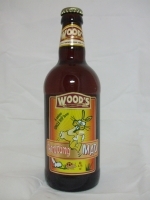 Wood's Hopping Mad Awareness of the ingredients of beers is growing, and the hop, which gives beer its most obviously identifiable and distinctive aromas and flavours, has come in for particular attention. Where once brewers would simply reach for their traditional varieties, now there is a whole repertoire of sensations with which to engage the consumer’s interest.
Single varietal beers, an idea borrowed from the wine world, contain only one, named variety of hop, rather than following the more usual practice of choosing several different varieties to cover the various functions of bittering, aroma and preservative.
One such is Hopping Mad, from a small but successful family-owned micro established in 1980 next to the Plough Inn at Winstantow in the Shropshire Hills, near the celebrated landscape of Wenlock Edge. This is another one of those British real ales in a bottle that’s derived from a draught recipe, in which form it won a silver Beauty of Hops award, though the bold flavours stand up well to the bottling process.
The beer was originally brewed as an easter special — the manic bunny on the label reveals a third meaning to the painfully punning name. The hop is Progress, a milder relative of the familiar British bittering hop Fuggle. However the beer also demonstrates the limitations of analogy; while wine is more-or-less 100% grapes, hops are only one among several ingredients in beer, all of which need to be carefully chosen to show them off to best effect.
The Woods get it right with a grist of pale malt, crystal malt and torrefied wheat (similar to the puffed wheat found in breakfast cereals), giving a warmly amber-hued beer with a thick white head which emerged from my bottle slightly cloudy — but according to the label it’s fine to drink with our without the yeast deposit. The aroma is distinctly hoppy and slightly peachy at first, quickly mellowing out with subtle traces of earthiness, fennel and a touch of liquorice.
The palate is crisp but full, and subtly complex, with touches of demerara sugar and peach softening an overall dry beer with spicy fennel-like hops. My bottle was well-conditioned, with a gentle carbonation supporting the inviting softness. Hops and citric fruit come forward on the swallow, followed by a slowly developing bitterness that becomes quite intense but always well rounded. The beer is finally quite tongue-drying, but with plenty of soft malt and a touch of vanilla in the finish.
Try also City of Cambridge Hobson’s Choice (First Gold), Gale’s Conquest (Fuggle), Iceni Phoenix (Phoenix), Pitfield East Kent Goldings (Golding)
Read more at ratebeer.com: http://www.ratebeer.com/beer/woods-hopping-mad/5882/
Originally published in What’s Brewing September 2003
Origin: Wainfleet, Lincolnshire, England
ABV: 4.5 per cent
Buy from Booths supermarkets
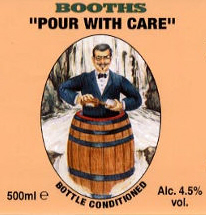 Batemans Booths Pour With Care Batemans Booths Pour With Care
Booths, a regional supermarket chain in northwest England, offers an imaginative range of bottled beers, including bottle conditioned ales, that puts its national competitors to shame. The range is driven by the personal passion of beer buyer David Smith, who believes there’s “a lot of mileage” in real ale in a bottle, so long as you put some effort into educating your customers – a point the larger supermarkets seem slow to grasp.
Booths put that philosophy into practice when it became the first supermarket to launch its own brand bottle conditioned British ale. Pour With Care – its name reflecting its educational mission – was commissioned from Batemans of Wainfleet and launched in May 2001 to great success.
Family-owned independent Batemans – a CAMRA cause célèbre in the 1980s when it was threatened with a hostile takeover – is well-loved for its self-proclaimed “good honest ales” in cask. Its own widely distributed bottled range includes a number of interesting specialities, but all of them filtered, though not pasteurised, since the brewery finds bottle conditioning “too unpredictable”. It has however created the occasional BCA as a special, and worked enthusiastically on the Booths project.
The recipe was developed from scratch, though Stewart Bateman says David had a very clear idea of the kind of beer he was after. It ended up a rubyish amber ale with a grist of 53% Maris Otter pale, 35% wheat and 12% crystal malts, hopped half-in-half with Goldings and Challenger. It’s fermented in open squares and bottled unprimed from racking tanks with yeast in suspension: like all Batemans beers it’s suitable for vegans.
With its big, smooth, yellowish head it actually requires pouring with more care than some BCAs in order to get it into the glass in one smooth movement. Once accomplished, there’s a fruity aroma with generous peppery and slightly earthy hops, chocolate and banana notes (possibly from the wheat?).
The palate is rich, full-bodied and slightly cakey with marmitey malt, marmalade and crystal malt sappiness, turning quite sternly dry but still fruitily aromatic. There are more hops in the lengthy finish, with its malt and chocolate tones becoming dry and bitterish, and mineral, iodine-like hints around the side of the mouth.
Overall this is a big, robust and fruity but elegant glassful in a style that might have come from a new generation micro, except that it’s also unmistakably a Batemans beer – a quality Stewart attributes to the brewery’s dominant yeast strain. It’s great to see this pioneering partnership has yielded such a praiseworthy result.
Try also Butts Barbus Barbus, Hogs Back BSA, Hop Daemon Leviathan
Read more at ratebeer.com: http://www.ratebeer.com/beer/booths-pour-with-care/14310/
Originally published in What’s Brewing August 2003
Origin: Newport, Oregon, USA
ABV: 6.5 per cent
Buy from specialist shops, festivals, Only Fine Beer (tel 020 7265 8388, www.onlyfinebeer.co.uk)
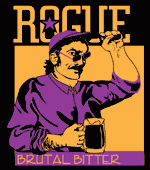 Rogue Brutal Bitter Rogue Ales, based in the Pacific Northwest, a heartland of US craft brewing, is one of the more established of the new generation of North American craft brewers. It began as a brewpub in Ashland, Oregon in 1988, moved to its current home in Newport in 1991 and now operates a handful of pubs around the state.
Its large 650ml bottles with their distinctive screen-printed labels have appeared on British shelves before, during Oddbins’ brief flirtation with North American beers a few years back, and I remembered being impressed with them then, so I was delighted to hear that they now have another British importer.
Strong beers in such big bottles may be offputting to British buyers, however, especially since, to answer recent speculation in these pages, at least some are still fermenting in the bottle, with yeast sediments to prove it. Brutal Bitter is one of these: originally an anniversary beer, it is described by brewer John Maier as a cross between an ESB-style and an IPA. The principal malt is English floor malted Pipkin from Beestons, with Cara Vienna and Cara wheat malt.
Like many new US beers the emphasis is on the hop character – it’s a single varietal brew featuring Oregon-grown Crystal, a hybrid derived from Hallertau capable of giving a huge aroma without dry hopping. But if the beer’s origins and forbidding name lead you to expect something only suitable for dedicated hopheads with cast-iron tongues, you’d be wrong: this is a notably complex and well-balanced beer.
BB pours a slightly hazy bronze-amber, lent a warm glow by the Vienna malts, with a thick white head and a fine bead. The aroma is complex and incontestably huge: citric at first, becoming more restrained and floral with a resiny freshness. Underneath is sticky toffee, dark nutmeg scents and a certain vegetal quality reminiscent of red burgundy. The palate is rich, silky and toffeeish but dry, balancing citric and apple fruit with slightly salty and meaty flavours laced with crackles of resiny hops.
The hops cling to the gums in the swallow, developing a richer bitterness at the back of the throat that dominates a very long finish, with slightly astringent citric flavours on the tongue, hints of bitter herbs and a dryness like very fine dark chocolate, though just softened enough by the underlying fruit and malt. Intense, yes, but certainly not brutal, and more like the beer equivalent of a tough but energising massage!
Try also Freeminer Speculation, Hogs Back BSA, Goose Island IPA (USA)
Read more at ratebeer.com: http://www.ratebeer.com/beer/rogue-brutal-bitter/581/
Originally published in What’s Brewing July 2003
Origin: Horsham, Sussex, England
ABV: 4.2 per cent
Buy from supermarkets
 Coniston Bluebird Bitter When the directors of Brakspear cashed in their prime piece of Thames-side, not only their own brands were affected. Among the homeless were a number of contract brews, including supermarket-listed Coniston Bluebird, originally an award-winning cask beer from the tiny micro at the Black Bull pub at Coniston in the Lake District which in bottled form had moved south when demand outstripped capacity.
At a time when a recognised geographical origin and a distinctively local character are increasingly seen as the key to sustaining the market in fine traditional produce, contract brewing rings alarm bells. This is especially true when, like Bluebird, the product flaunts its local credentials: the name commemorates the craft in which Donald Campbell met his death while attempting the world speed record on Coniston Water, and the label calls the Black Bull “the home of Coniston Bluebird”.
The actual brewery of origin was acknowledged in the small print of the Brakspear version, but though the beer has now moved to Hepworths at Horsham, recent bottles still carry an Oxfordshire address. This turns out to be the business base of former Brakspear brewer Peter Scholey, who took the contract with him upon the Henley brewer’s demise.
Bottled Bluebird is still a slightly stronger version of the draught variety, made with Maris Otter pale malt, about 5% crystal, and Challenger as a single varietal hop. The result is a rich coppery-golden beer with a white head, a nicely even condition and a notably hoppy aroma: resinous and slightly sweaty at first, developing spicy and flowery honeysuckle and geranium notes later.
The crisp cereal-malt palate has drying hops evident from the first sip, with more floweriness and a slightly salty tang. The hops become more pronounced in a peppery swallow, developing over a complex finish which is always firmly hoppy but never overbearing, with cedar, grapefruit, ashy hints and a persistent but rounded bitterness.
Scholey has worked hard to match the Brakspear version, and the beer’s creator, Coniston’s Ian Bradley, says he can’t tell the difference. Based on my notes of its predecessor, I’d say the Horsham beer may be slightly heavier and less strikingly flowery, though with a longer finish.
Overall this is a refreshing ale that exhibits an American-style flair for hop character balanced by a very British idea of a rounded bitter, and I’m relieved that such an enjoyable beer is still on the shelves. Let’s hope the misleading labelling will be corrected: a beer this good doesn’t need to pretend.
Try also Butts Barbus Barbus, RCH Pitchfork, Anderson Valley Poleeko Gold (USA), Jopen Haarlems Hoppenbier (Netherlands)
Read more on ratebeer.com: http://www.ratebeer.com/beer/coniston-bluebird-bitter-bottle/5493/
Originally published in What’s Brewing June 2004
Origin: Saint Sylvestre Cappel, Nord, France
ABV: 8 per cent
Buy from Specialist shops, beer festivals
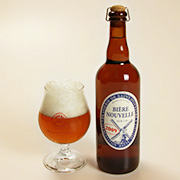 Saint-Sylvestre Bière Nouvelle The low-lying countryside of northern France is dotted with farmhouse breweries. Much of this area was formerly Flanders: Dutch personal and place names are everywhere and the language itself persists in places. But the local beer styles are distinct from those of neighbouring Belgium.
The village of Saint Sylvestre Cappel (St Sylvester’s Chapel) between Steenvoorde and Hazebrouck boasts around 1,100 inhabitants and one of the finest breweries in the region, simply named Brasserie de Saint-Sylvestre. Though ownership records date only from 1850, there was a brewery here since before the Revolution. It was sold in 1920 to the Ricour family who still own it today.
The brewery offers the characteristic local speciality, bière de garde, a strong pale ale style developed in the mid-19th century to quench the thirst of local miners and farm workers. Before modern refrigeration techniques became widely available, brewing good pale beer in summer was impossible, so these were “beers for keeping” to drink in the summer season.
Saint-Sylvestre’s flagship beer, Trois Monts, is named after the three modest hills that surround the village and once staked out the range of the brewery’s dray. This beer is now pasteurised and available all year round, but in 1985 the Ricours revived the seasonal tradition with a speciality brewed in December for release in May.
Borrowing from wine terminology, this beer is labelled “Bière nouvelle sur lie”, new beer on its lees, for the local market; export bottles bear the name Bière de Mars, March beer. The most recent harvest of pale and Munich malts, wheat and local hops are used. After its initial conditioning the beer is filtered and placed with yeast and sugar primings in thick brown 75cl bottles, their corks held in place with metal clips.
Bière nouvelle comes out an attractive ruby-tinged amber colour with a fine soft foam head. The restrained hops and malt aroma yields a little spice and creamy yeast, leading to a very full malty palate with a moussey texture and a firm nuttiness characteristic of the best bières de garde.
It’s slightly tannic on the swallow with the faintly sour signature of a stored beer, leading to a warming, nicely malty finish with more nuttiness and apple and pineapple fruit and, eventually, quite bitter hops. Overall this is a big, full-bodied and rather stern beer that takes its tradition seriously, very rewarding of a contemplative sip.
Try also: Trois Monts, Castelain Ch’ti Ambrée, Jeanne d’Arc Grain d’Orge, Vapeur Saison de Pipaix (Belgium)
Read more at ratebeer.com: http://www.ratebeer.com/beer/st-sylvestre-biere-nouvelle/7326/
Originally published in What’s Brewing May 2004. Note since publication the brewery has been taken over and closed by Fuller’s.
Origin: Horndean, Hampshire, England
ABV: 4.8 per cent
Buy from Specialist stockists, brewery’s pubs
 George Gale Festival Mild Bottle-conditioned mild must be one of Britain’s rarest styles, perhaps because the low strength of most modern milds isn’t thought robust enough. Even milds at more old-fashioned gravities are hard to find.
World classic Sarah Hughes Dark Ruby from the celebrated Beacon brewpub in Sedgeley is currently unavailable in bottled form while the brewer looks for a new bottler. B&T of Shefford are reviving last year’s successful seasonal, Black Dragon Mild, but hadn’t got any bottled in time for a review. Thankfully George Gale, a family-owned independent dating from 1847 and still operating from an 1869 “tower” brewery, was able to help this column mark Mild Month.
Gales are well-known for strong, long-maturing BCAs such as Prize Old Ale and for their well-regarded draught special bitter HSB. Festival Mild is so named because it first appeared in cask form by special request at the Farnham Beer Festival in May 1991.
It was successful enough to retain as a regular brand: although it is still the lowest-selling of the brewery’s draught range, its stability during conditioning makes it viable at low volumes. It’s won multiple awards, most recently best in class and reserve champion at the Winter Beer Festival.
It’s brewed with Maris Otter pale malt, with light crystal and black malt supplied by Simpsons, and hopped with Fuggles, Challenger and Goldings, the latter for aroma as well as bitterness. With enough residual gravity left from conditioning, no priming is used for the bottled version, which was originally aimed at the US market and is presented with a wine-style ‘capsule’.
The beer is a very dark brown colour, near black, and my well-matured bottle poured with almost no head, although there was a pleasantly restrained sparkle in the mouth. The aroma is typical of a good dark mild: restrained and warmly malty, with hints of chocolate, strawberry and straw-like.
The palate is smooth, dark and sweetish, almost like chocolate milk, with lightly acidic black cherry and raisin fruit and some spicy hoppiness that becomes clearly bitter as it develops.
Earthier hops asserts itself on the swallow, leaving a sting of bitterness and powdery dryness in the longish finish that places the beer among the less mild milds, although it’s never overdone. You’re also left with faint roasty-ashy notes and a little more soft fruit.
Overall it’s just what you’d want from a good mild: easily drinkable but with plenty of rich flavour to discover should you choose to linger, and an individual signature from well-judged hopping.
Read more at ratebeer.com: http://www.ratebeer.com/beer/gales-festival-mild/4331/
Originally published in What’s Brewing April 2003
Origin: Woodbastwick, Norfolk, England
ABV: 7 per cent
Buy from Specialist stockists, direct from the brewery (tel 01603 722218, www.woodfordes.co.uk)
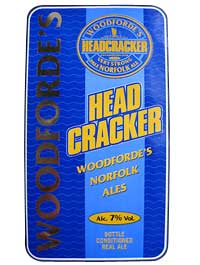 Woodfordes Headcracker East Anglia provides rich pickings for lovers of good speciality ales: the current Good Beer Guide lists 15 independent brewers in Suffolk and 11 in Norfolk, including a good number of award-winning names. Among these is Woodforde’s, perhaps best known for Wherry Best Bitter, a former Champion Beer of Britain, though in fact its most honoured beer is Headcracker, which in draught form recently won Champion Draught Barley Wine of Britain for the third time.
Wherry was Woodforde’s inaugural beer when the brewery was founded in 1981 at Drayton near Norwich by former homebrewers, who named it after an 18th century beer-loving Norfolk vicar. Since 1989 it’s been based at Woodbastwick, northeast of Norwich, on a site with its own water supply from a borehole. This pretty village in the Broads is much-visited by tourists, a market served by the brewery’s shop and visitor centre – and a range of its ales in bottle-conditioned form to take home. It also boasts three tied pubs.
Those familiar with Wherry won’t be surprised by the brewery’s take on a barley wine: Headcracker is also light in colour and notably hoppy for its style. The grist is almost entirely pale malt – Norfolk Maris Otter from Simpsons at nearby Tivetshall – with just a little caramalt. The result is an attractive golden colour, notably effervescent, and pours with a loose, foamy head. The heady aroma is instantly striking: full of peachy sherbet fruit and pungent spice, with the whiff of deeper, more earthy resins from Styrian Goldings hops.
The palate is tongue-tingling and slightly astringent, with a bitter-herbal, tea-tree oil-like character over an underlying slightly sweet malty body, and something of the vinous character appropriate to its style. Held in the mouth the beer becomes very warming, almost hot, while swallowing yields more hops and sherbety fruit salad. A deep, well-rounded resinous bitterness then slowly develops in the back of the mouth with a slight drying of the tongue and hints of sweetish nuttiness.
The name, with its encouragement to ABV-fixated headbanging, does the beer a disservice – though forward and uncompromising, this is overall a very elegant beer, inviting slow sipping with its refined malt palate, obvious alcohol and complex and distinctive but never aggressive hop flavours. And although officially given only six months of shelf life, it could also be laid down for much longer: I’d be interested to taste how it mellows with age.
Try also: Bush 7% (Belgium), Cottage Norman’s Conquest, Hogs Back A over T, Tegernsee Heller Bock (Germany)
Read more on ratebeer.com: http://www.ratebeer.com/beer/woodfordes-headcracker/18392/
Originally published in What’s Brewing March 2003
Origin: Amsterdam, North Holland, Netherlands
ABV: 6.5 and 8 per cent
Buy from Specialist suppliers, including Beer Barons (www.beerbarons.com)
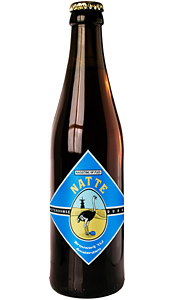 't IJ Natte In a matter of years the Netherlands has gone from a Heineken-dominated desert to boasting one of the most interesting beer scenes in Europe, with an eclectic and innovative approach that mixes national traditions with inspiration from neighbouring countries. ‘t IJ brewery is the oldest-established of the new breed of brewers, founded in 1985 by former pop star Kaspar Peterson.
The name is pronounced like the ‘et’ in ‘violet’ then a cross between ‘eye’ and ‘ay’ (not “tidge” as I once memorably heard from a British importer!), and refers to the body of water that separates Amsterdam’s historic centre from its northern suburbs. The brewery isn’t actually on the IJ, but under a windmill in the old harbour area to the northeast of the centre, in an old bathhouse, which also houses a basic but attractive and nearly always busy tasting room. All the bottled beers are unpasteurised and unfiltered.
Natte and Zatte (“wet” and “drunk”) were two of the brewery’s earliest lines. They’re labelled as a dubbel and tripel respectively, recalling the many Belgian brewers that pair a weaker monastic-style dark ale with a stronger golden one following the model of the Westmalle trappist brewery. But while these beers nod to the abbey style in strength, fruity complexity and slight sweetness, they otherwise go their own way.
Natte is more a deep ruby amber than the brown of a typical double, and its crystal malt tones recall some British micro-brewed strong bitters. There’s a spicy, yeasty, creamy aroma with vanilla and tobacco, and a full fruity palate with citric acidity, becoming slightly smoky and spicy. The beer stays fruity in the finish with well-rounded, faintly metallic hop flavours and a touch of chocolate. Overall this is a very drinkable, easy-going and cheerful beer.
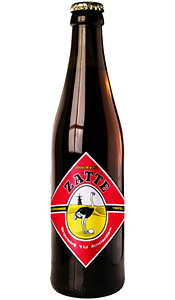 't IJ Zatte Zatte is a golden ale with an amber glow and a rich white head. Like Natte it has a lively, fecund and creamy aroma, but with a whiff of earthy hops and some pastille-like tones. The sweetish palate has a foamy texture and fruit and herb flavours, including coriander. A drying quality emerges from herbs and hops but overall this is much milder than the average triple. There’s a flash of alcohol on the swallow, and a long, custardy smooth finish with tangy herbal hints, remaining sweetish to the last but never cloying.
Though relatively easily to track down in their home country, ‘t IJ beers have been elusive in the UK: it’s good to see the specialist shops taking an interest at last.
Try also: De Leckere Dubbel, Maasland d’n Schele Os Tripel, Schelde Zeezuiper, La Trappe Tripel,
Read more at ratebeer.com:
http://www.ratebeer.com/beer/t-ij-natte/6057/
http://www.ratebeer.com/beer/t-ij-zatte/6058/
Originally published in What’s Brewing February 2003
Origin: Wiveliscombe, Somerset, England
ABV: 6.6 per cent
Buy from Tesco
 Exmoor Beast Wiveliscombe was once one of southwest England’s most important brewing towns, home to the Hancock brewery between 1807 and 1959. In 1979 a new independent company revived brewing at the Hancock site, and immediately started hoovering up awards. Now once again Somerset’s largest brewery, Exmoor entered the bottled beer market in 1997 when a bottled version of its popular Gold earned supermarket listings.
The winning streak continued in 2002 when Beast, the brewery’s second bottled beer, was named the best Autumn beer at the Tesco Beer Challenge. Once again it’s derived from a draught beer, a strong porter-style beer available from October to April and first brewed ten years ago.
The name commemorates the mysterious large animal that is said to stalk Exmoor, preying on the local livestock and thought by some to be an escaped black leopard. At 6.6% the beer certainly has a bite and 2002 was the first year it was eligible for the Challenge, which had formerly imposed a 6% limit on entries.
Brewed from pale, crystal and chocolate malts and hopped with Goldings, Challenger and Brewers Gold, the beer turns out as dark in colour as the beast, a deep chestnut brown with a bubbly beige head. There’s a fairly light aroma that is mainly malty and toffeeish, with scents of leather, coffee and gravy and faint fruity esters.
Initially the palate has a very roasted malt character which mellows out to become more like a succulent bitter, balanced by well-integrated hops, black coffee flavours and some orange fruit. The condition is quite sparkling but without too much gas.
The beer turns fruitier on the swallow, with a finish that contrives to be both satisfyingly roasty and refreshingly cool. It turns quite tangy around the edges of the mouth with moreish Challenger hop flavours emerging, but although the longish finish turns nicely chocolatey it is never really bitter.
Overall, Beast combines plenty of dark flavours at an old-fashioned strength with a light texture that makes it appealingly drinkable. To my mind this is just what you should expect from a good porter, setting it apart clearly from dark milds and stouts, and Beast does the job admirably.
The one gripe is that it’s not bottle-conditioned. While you shouldn’t let this put you off – even in pasteurised form it can give many BCA beers a good mauling – it would be interesting to meet a live beast with even sharper claws.
Try also:Aldaris Porteris (Estonia), Burton Bridge Porter, Salopian Entire Butt, Sierra Nevada Porter (USA), Wickwar Station Porter
Read more on ratebeer.com: http://www.ratebeer.com/beer/exmoor-beast-bottle/70258/
|
Cask  This pioneering new book explains what makes cask beer so special, and explores its past, present and future. Order now from CAMRA Books. Read more here. This pioneering new book explains what makes cask beer so special, and explores its past, present and future. Order now from CAMRA Books. Read more here.
London’s Best Beer  The fully updated 3rd edition of my essential award-winning guide to London’s vibrant beer scene is available now from CAMRA Books. Read more here. The fully updated 3rd edition of my essential award-winning guide to London’s vibrant beer scene is available now from CAMRA Books. Read more here.
|





 Batemans Booths Pour With Care
Batemans Booths Pour With Care








